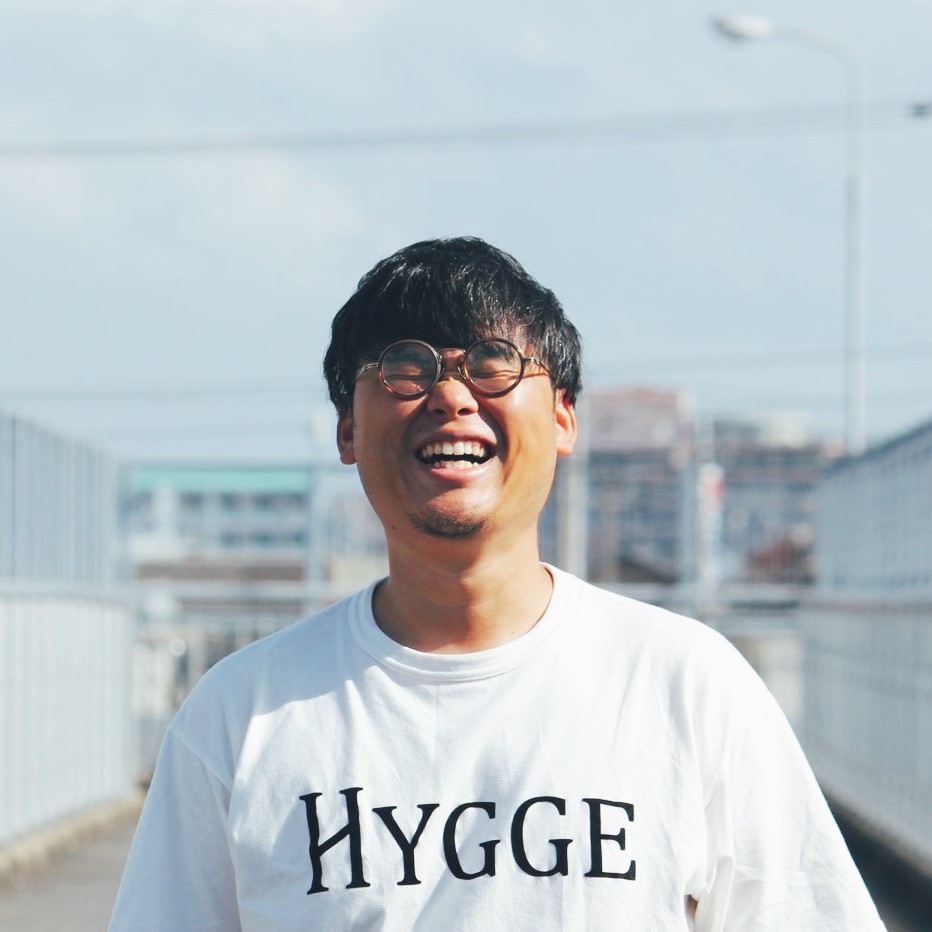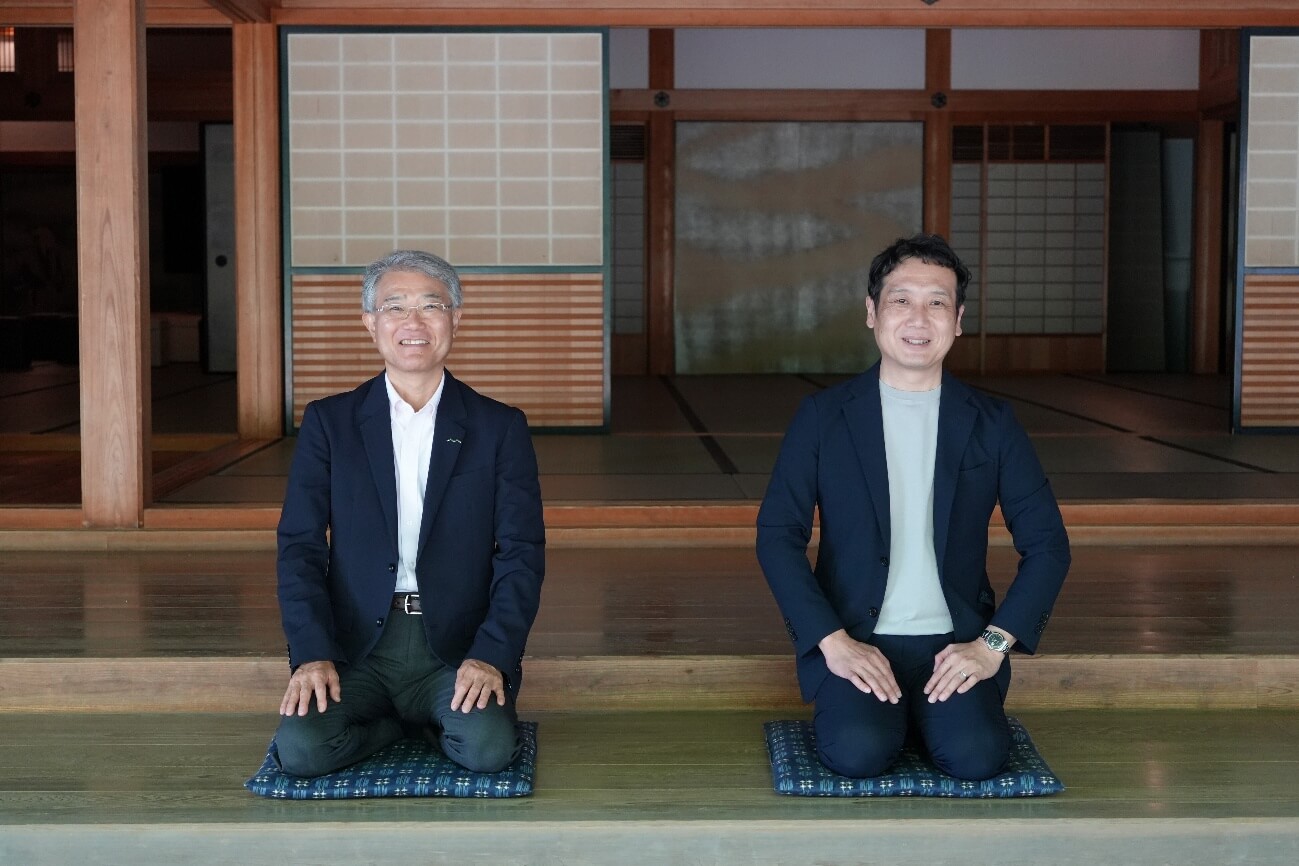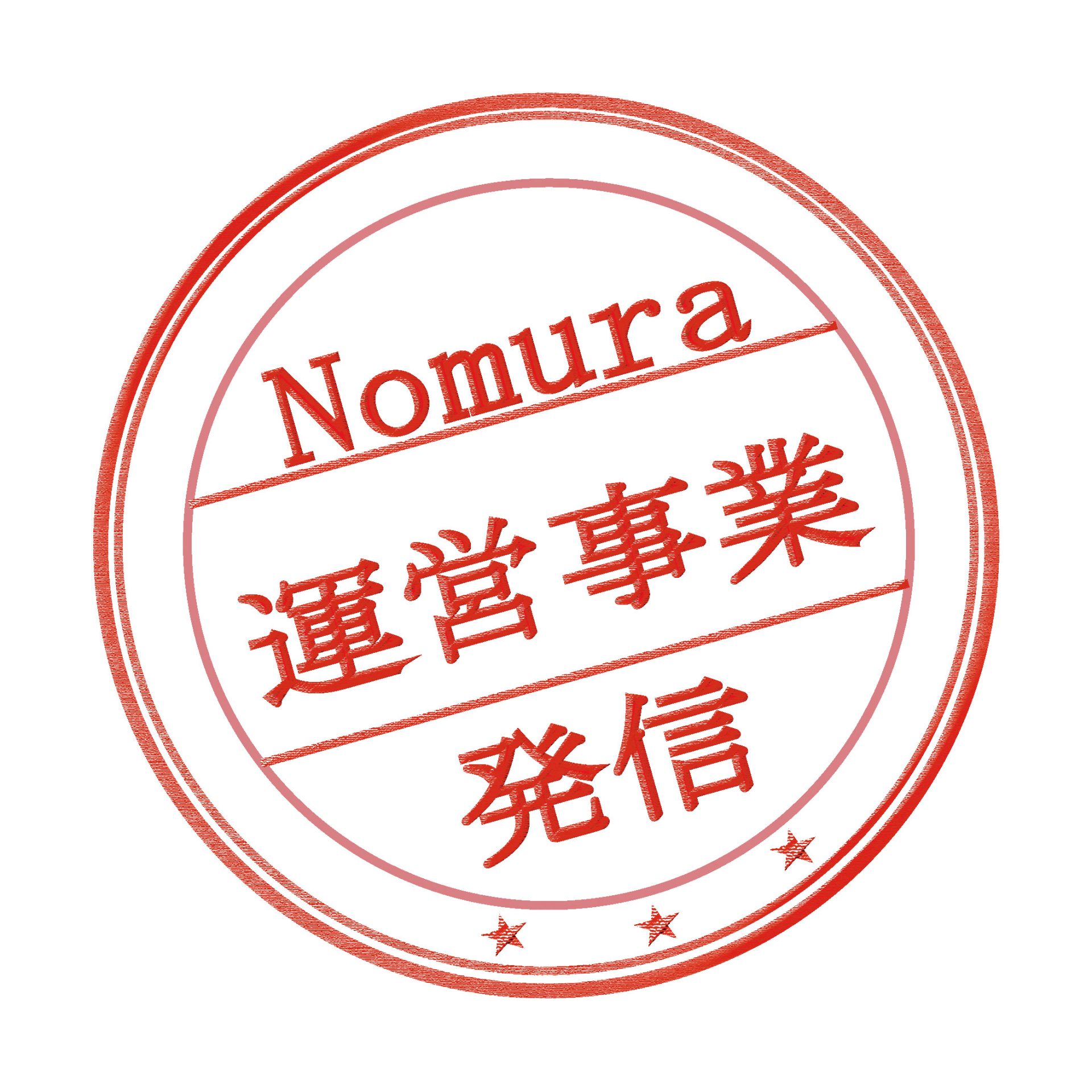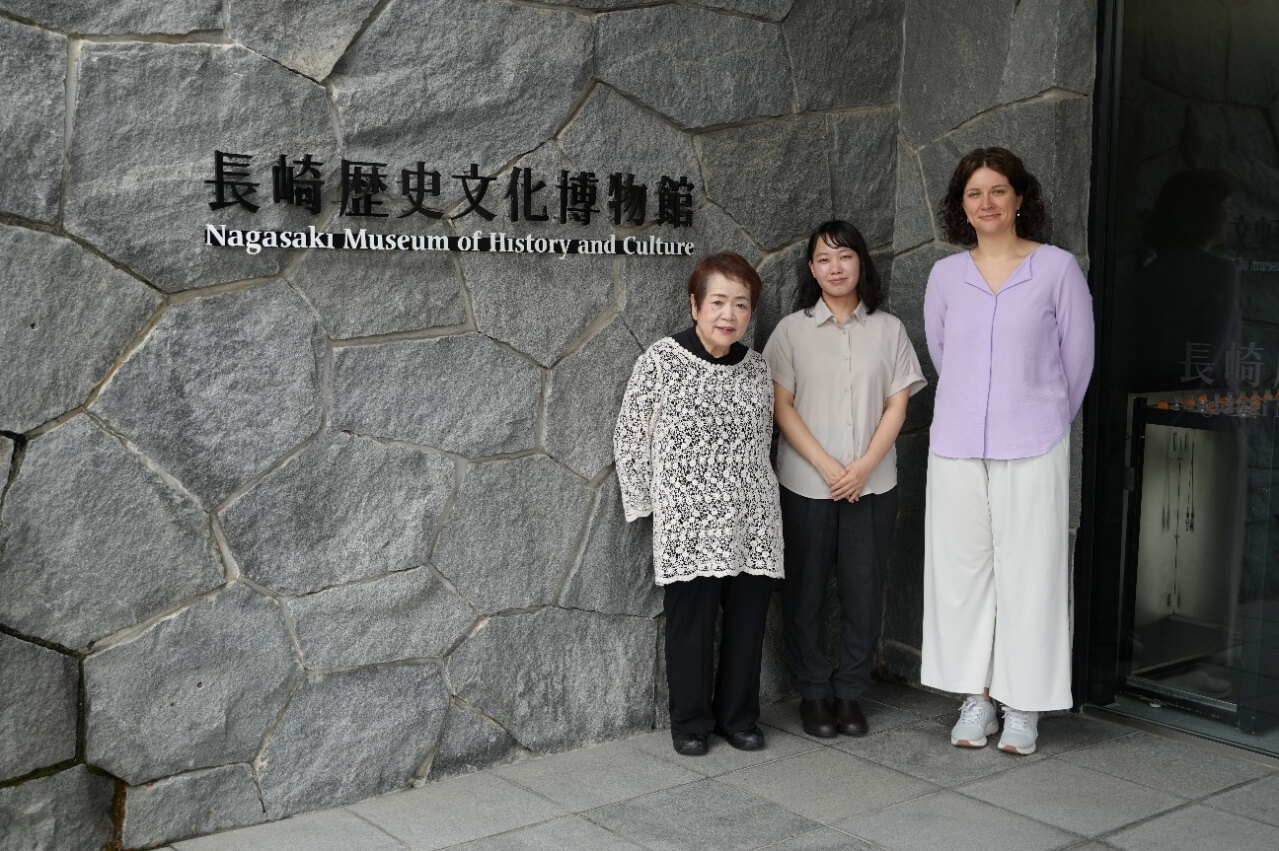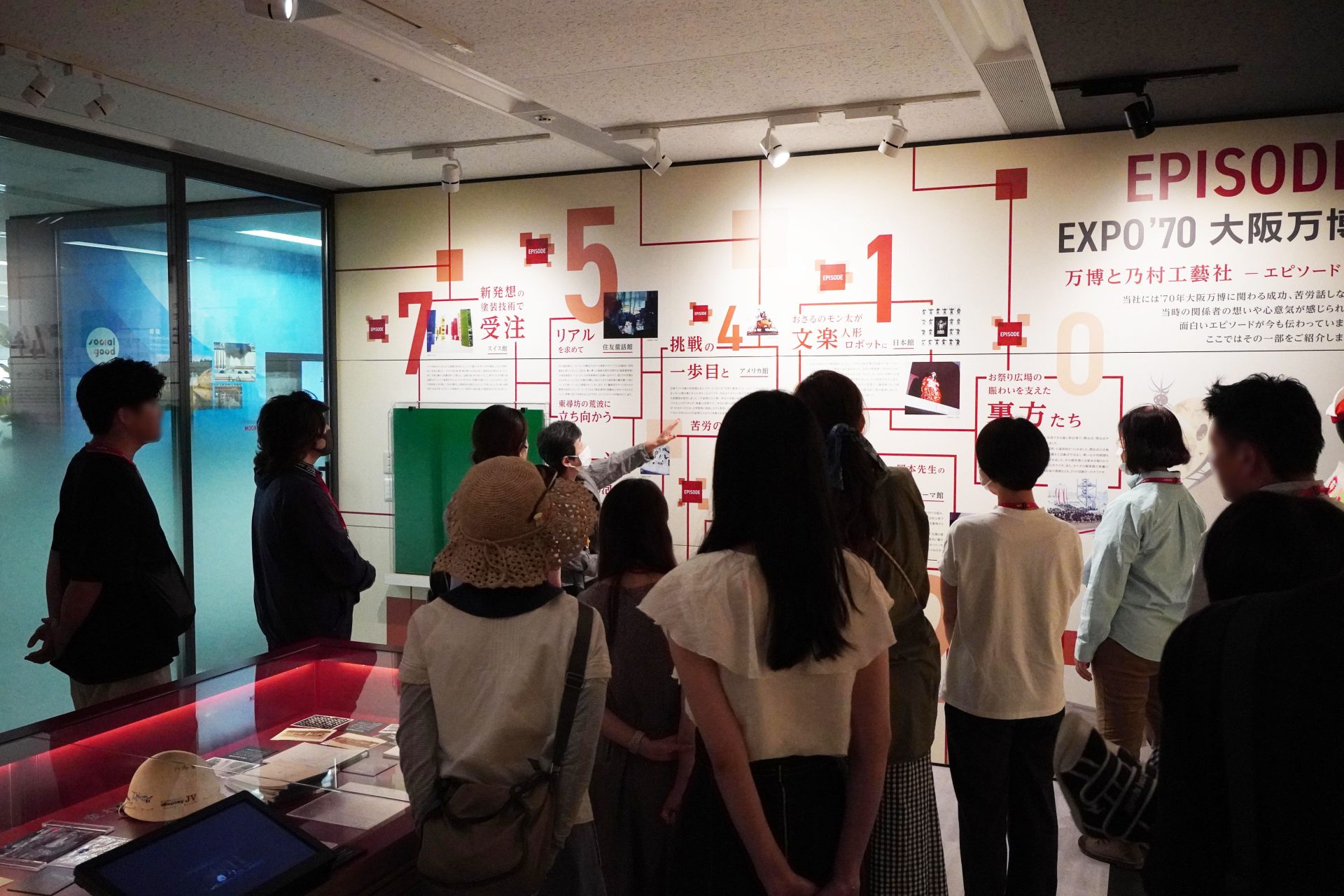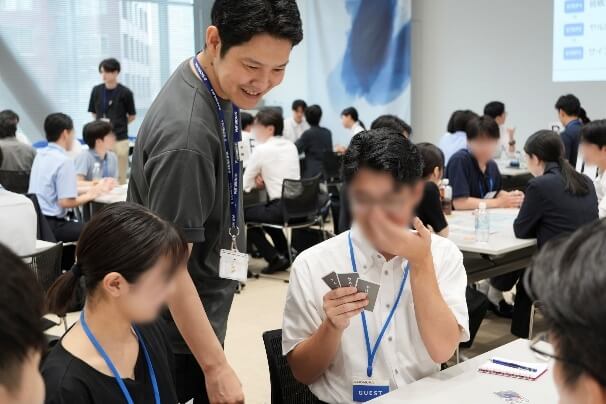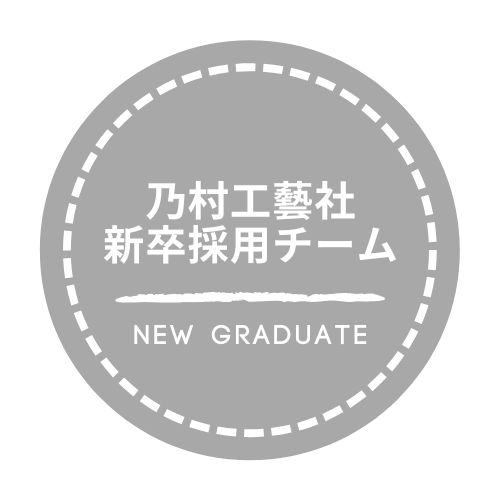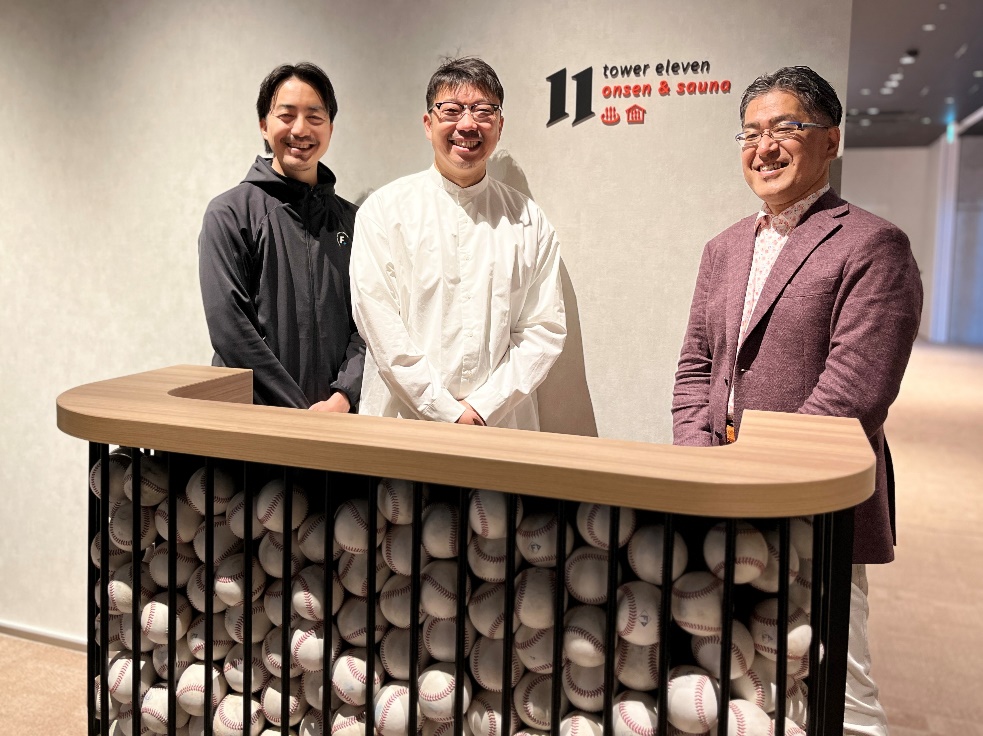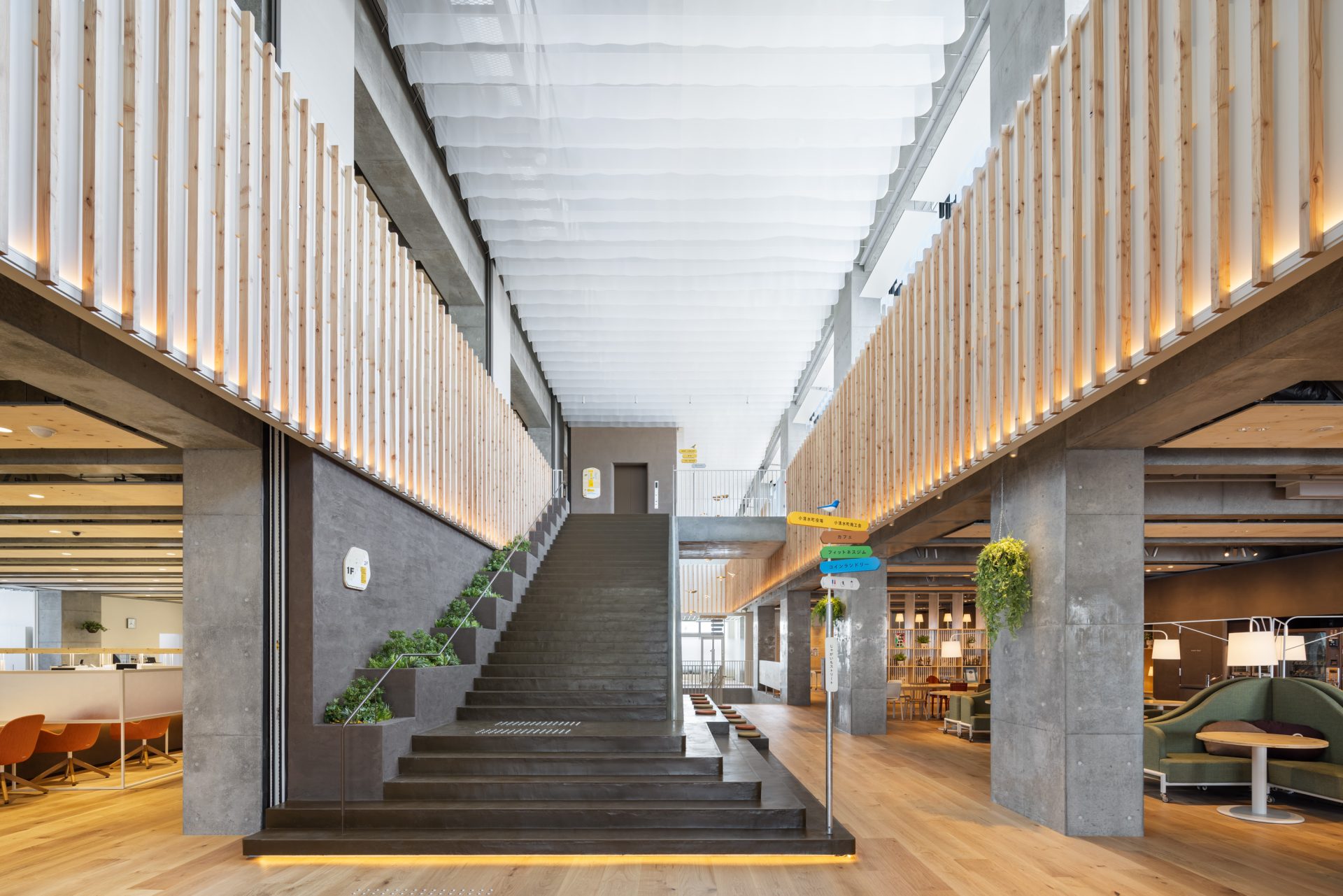
A design that loves the town and is loved by the town | Koshimizu Town Disaster Prevention Center Complex Government Building "Watashi-no"
2024/04/09- text and edit by
- Yuga Okamoto
May 2023. The town hall of Koshimizu Town, a small town in Hokkaido, has been reborn as Watashino, a complex government building serving as a disaster prevention base for Koshimizu Town.
In addition to the town hall functions, ``Watashino'' also has a coin laundry, a fitness gym and studio, a cafe, and a community space. Update the town hall from ``a place you don't go to unless you have something to do'' to ``a place you want to come to on a daily basis,'' making it a familiar and central presence in the town. It has features such as:
NOMURA Co., Ltd. was involved in the project from the basic planning stage, and was responsible for not only planning and spatial design, but also facility naming, VI design including the logo, and PR at the time of opening. We have teamed up with a number of private companies to be involved in this project.
Unlike the previous article, which focused on the outline of the facility and project, this time we will focus on the architectural design firm that worked with us on the design. Atelier Bunk While looking back on the project in a conversation with Mr. Key points in creating this facility with the theme of bustle and disaster prevention We talked about it. The facilitation was provided by Yumasa Okamoto, the planner in charge of this project.
Previous article: Supporting small towns in their big challenges. |Koshimizu Town Disaster Prevention Center Complex Government Building Watashino
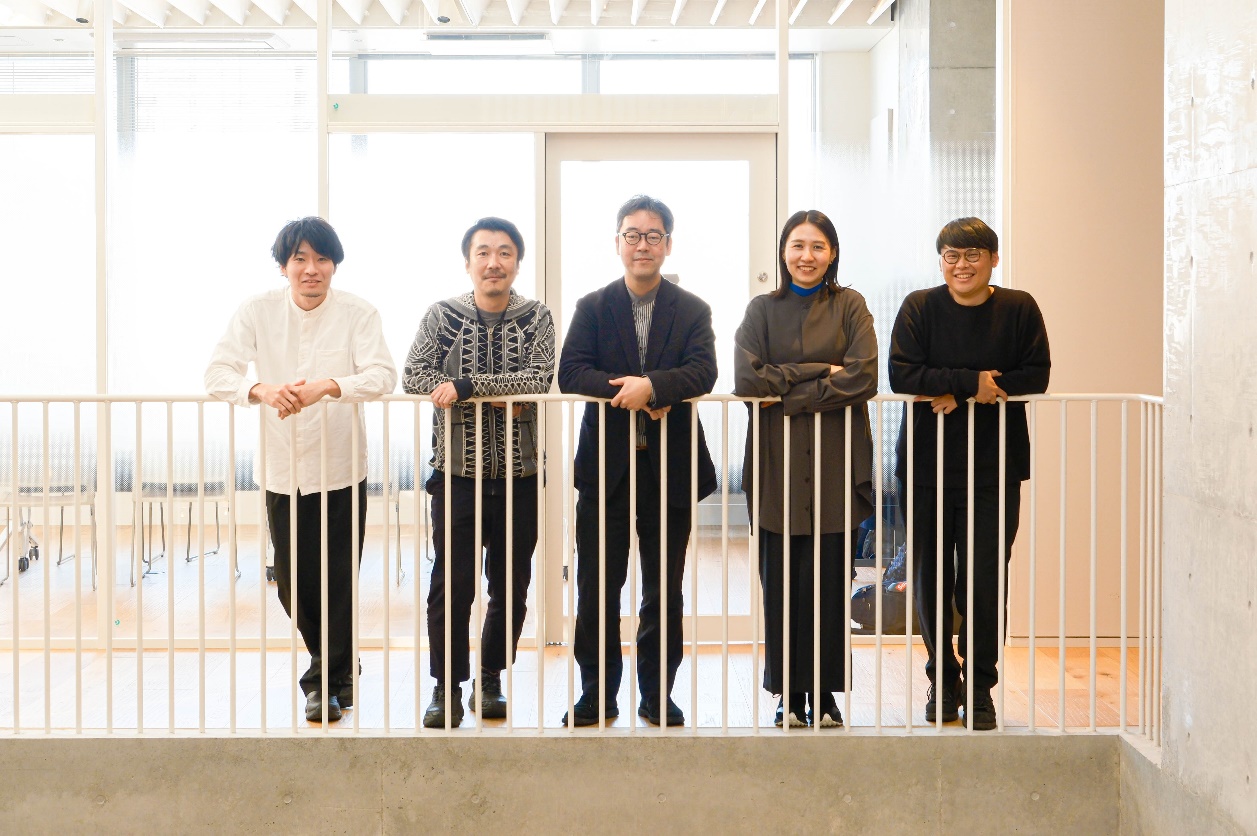
From the left
Atelier Bunk Design Department Chief Shizen Otsuji
NOMURA Co., Ltd. Creative Headquarters Design Center Designer Takaaki Tani
Atelier Bunk Executive Officer and Design Manager Ken Murakuni
NOMURA Co., Ltd.
NOMURA Co., Ltd. Creative Headquarters Future Creation Research Institute Planner Yumasa Okamoto
Original layout planning and zoning
Okamoto
Atelier Bunk was awarded the job through a proposal and joined the project a little earlier than we did. What kind of proposals did you make at the beginning of the project?
Mr. Otsuji
The planned site was wide from east to west, including the existing government building, and there was a difference in elevation from north to south, so the layout plan was to approach it from the town road on the south side. However, when we unraveled the history of the town, we learned that a shopping street developed between two rivers, and that it became the current national highway. Looking at the hazard map, the west side of the site was the flooded area, while the national highway side (east side) was out of the area. Therefore, by locating the new complex government building closer to the national highway, we centered our proposal on creating a new, lively landscape that inherits the town's history. Specifically, by creating three entrances and exits that are easily accessible from surrounding bus stops, hospitals, shopping streets, etc., the policy was to ``create a nodal point for urban development that can be explored on foot.''
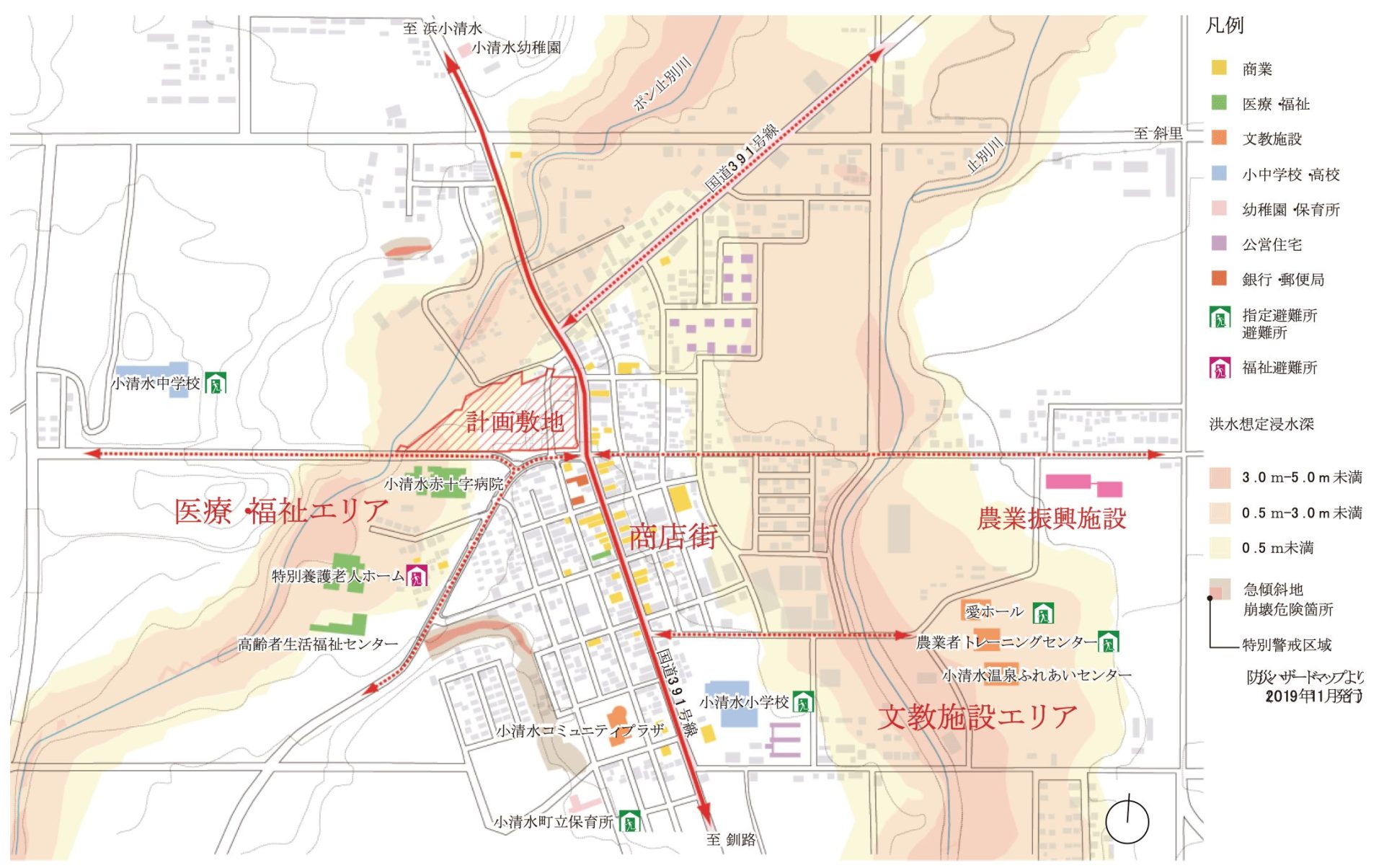
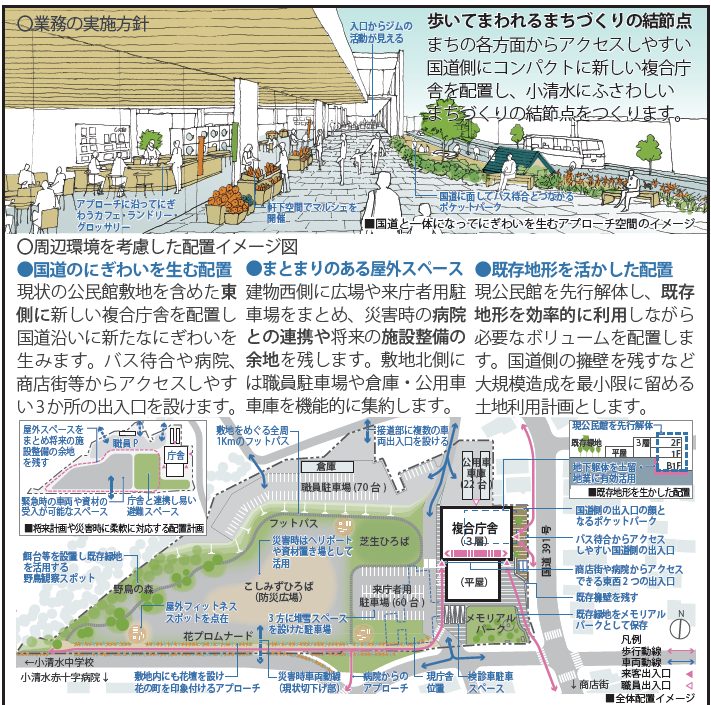
Excerpt of proposal materials at the time of proposal
valley
I like the themes of ``creating a new landscape on the national highway'' and ``getting around on foot'' while keeping in mind the bustle of the town. It's great to see pedestrians being looked after in an area where there is a lot of car use.
Mr. Murakuni
Initially, we proposed functional zoning within the facility based on a similar philosophy. Our proposal was to place the lively functions (café, fitness, laundry, etc.) on the national highway side so that the bustle inside could be seen from the national highway, similar to a shopping street, but convenience and practicality were also important. in. As we discussed this with people from the city hall, we decided that the zoning at the start of the basic design would look like the diagram below, with the focus on the west side near the parking lot, where the liveliness and functionality would be concentrated.
However, even so, we paid special attention to the functional placement of the building on the national highway side, as it serves as the ``face of creating vitality'' for the town.
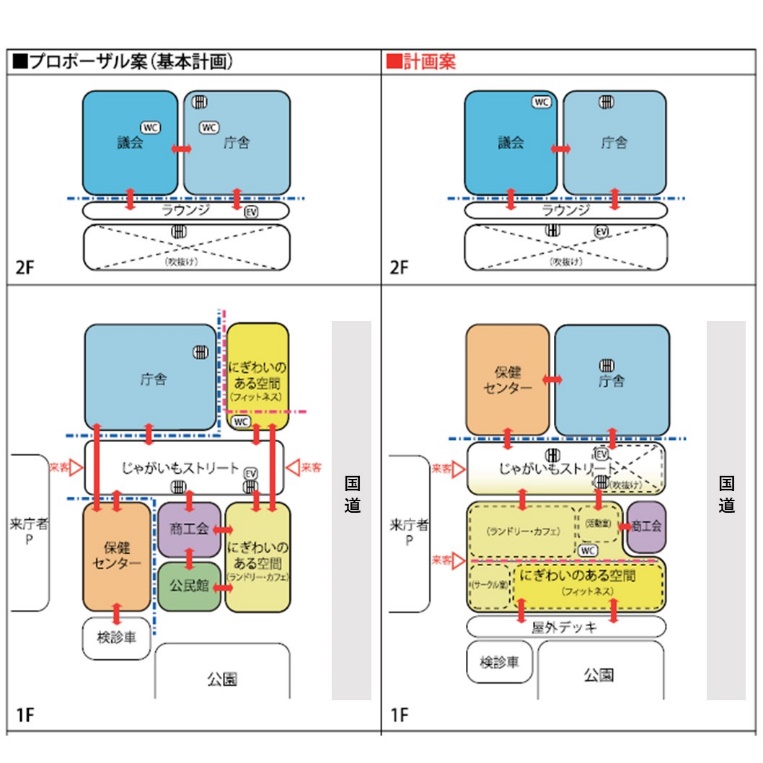
Proposal draft (left) and plan at the start of basic design (right)
Okamoto
It's true that the activity room we're in now faces the national highway and is a comfortable space. Activities in this room can be seen from the outside, and both office staff and townspeople seem to be happy to use this space.
According to a town hall employee, the activity room is being used much more frequently by town residents than the previous building.
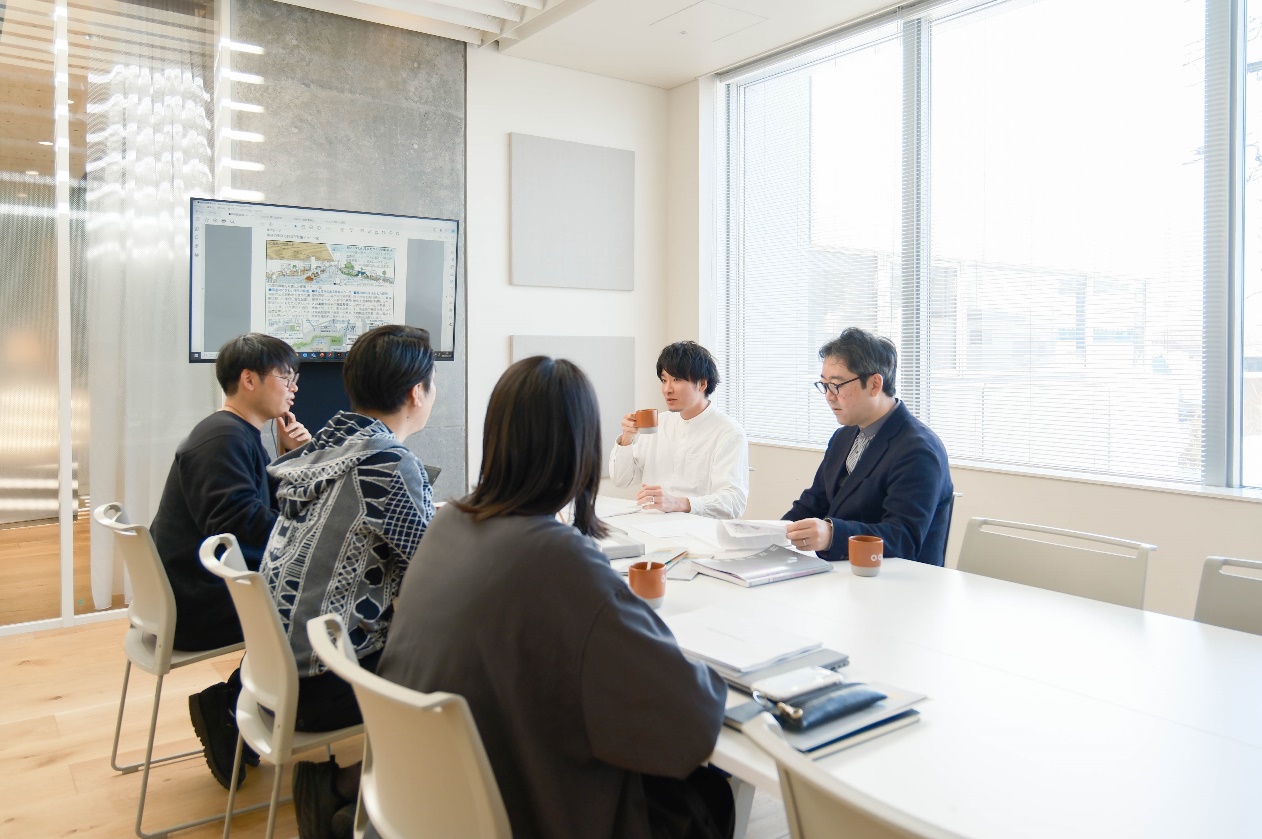
Activity room facing the national highway with bright light
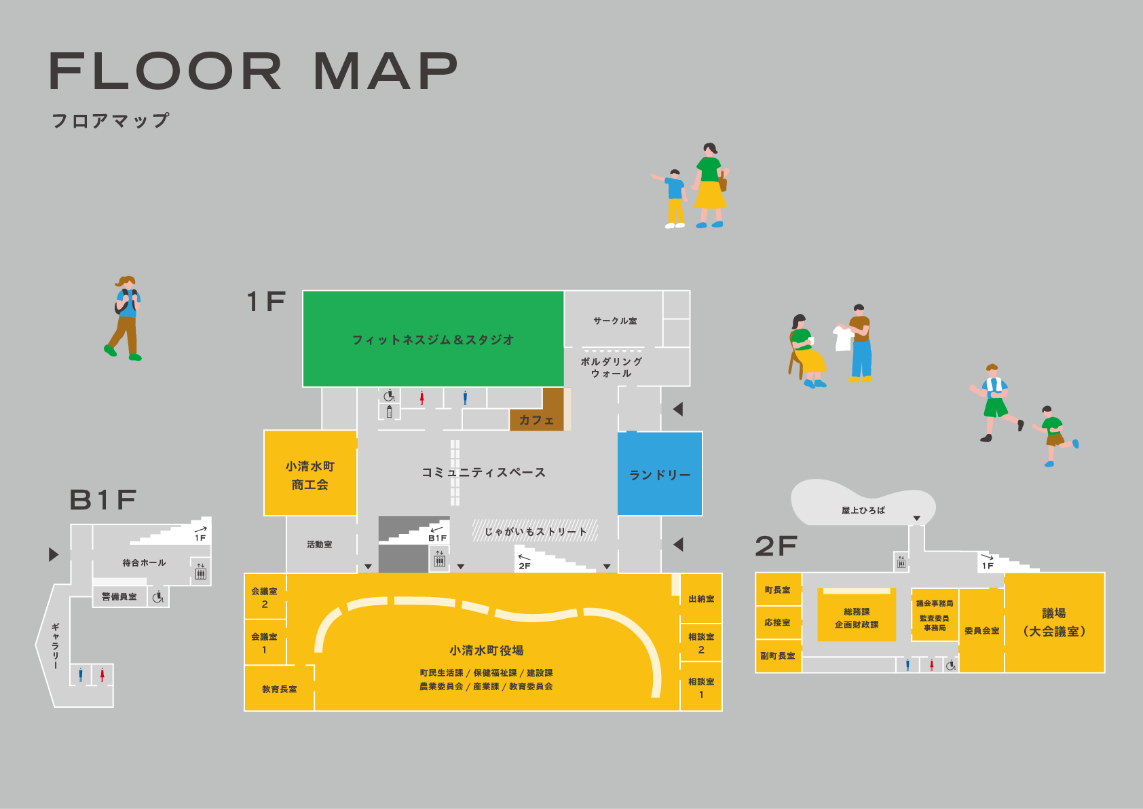
final floor zoning
The point is potato street
Okamoto
As Mr. Otsuji said, in addition to ``vibrating the town,'' ``being able to walk around'' was certainly an important concept.
From the beginning of our involvement, the line of traffic that passes through the government building called ``Potato Street'' and exits to the national highway was symbolic, and because this line remained unchanged until the end, we were able to rely on it for various discussions.
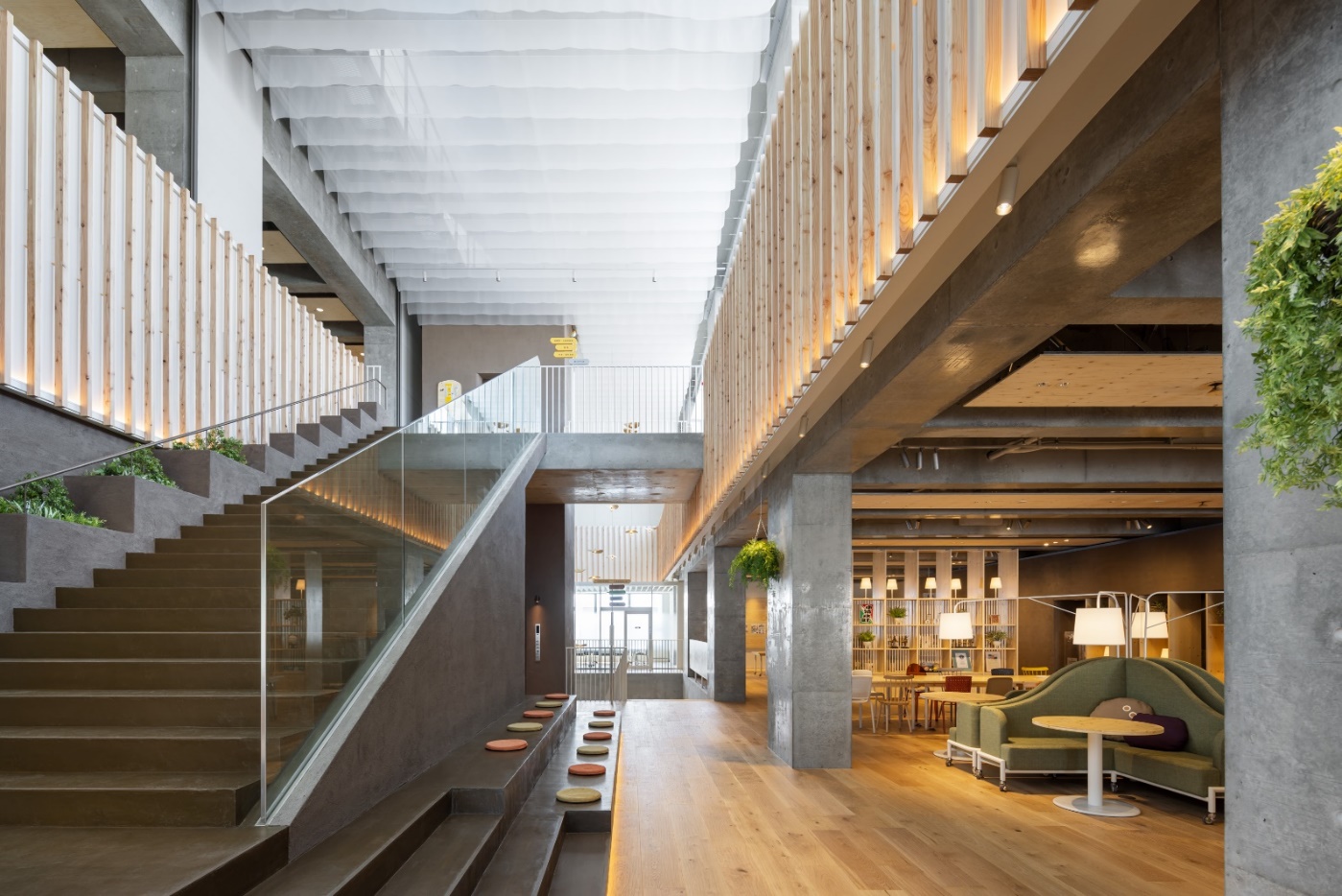
From the entrance, go between the stairs and the community space, pass through the first basement floor, and exit to the national highway where the bus stop is located on ``Potato Street.''
Mr. Otsuji
When designing public facilities, we are conscious of the high degree of freedom that ``people can walk through and access from anywhere.'' In that sense, ``Potato Street'' was a key space for the project.
Additionally, since this was a facility with multiple functions, I felt that the way the common areas were organized was important from a security and operational perspective.
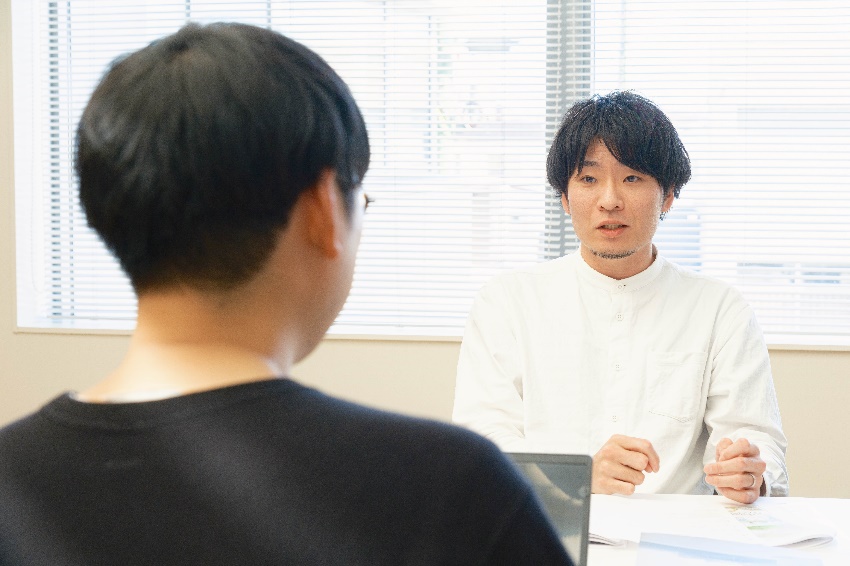
Mr. Murakuni
At the same time, we are conscious of ``creating internal space externally.''
We designed Potato Street, the center of the facility, to be a comfortable and bright place where you can feel half outside even though you're indoors, especially in the winter when it's so cold that it's difficult to go outside. I came here today for the first time in a long time, and I was happy to see that the high sidelights (tall windows) were shining in a pleasant light, creating a bright outdoor atmosphere.
I just passed the mayor on Potato Street, and it felt like we had just bumped into each other on the street.
We even had a conversation like, "Where are you going?" lol
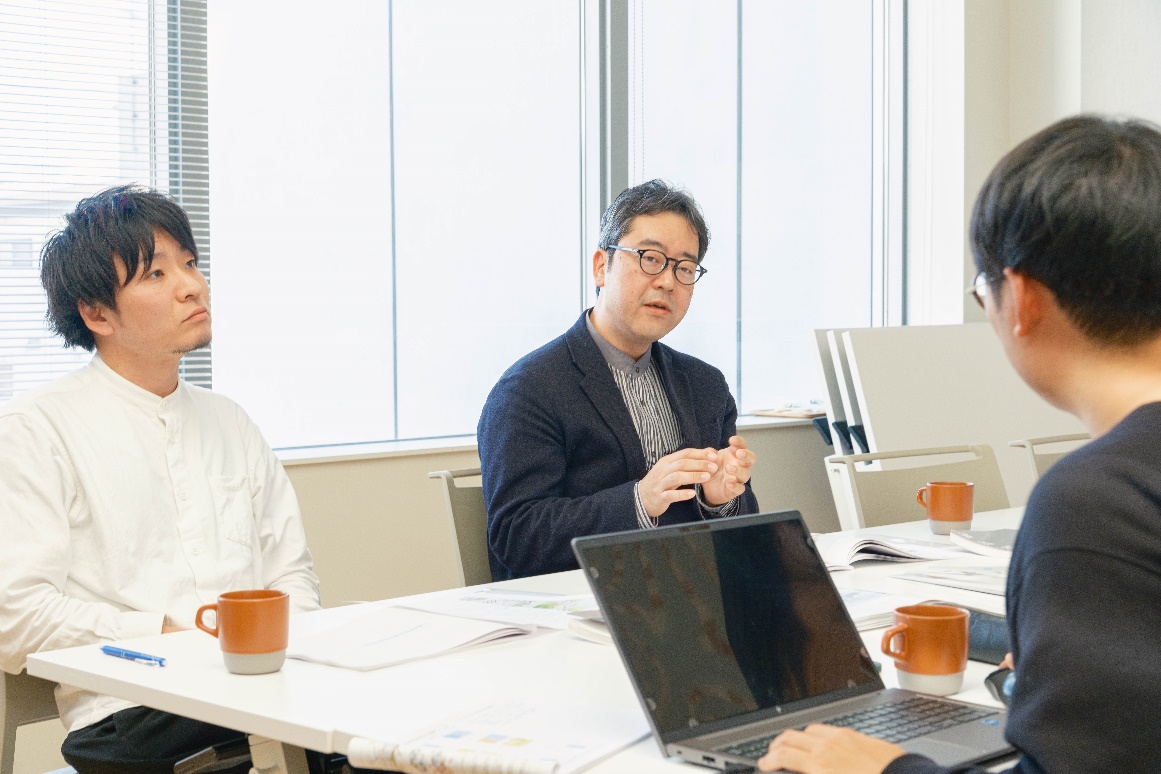
valley
I also feel that very much.
The ceiling would normally be dark and heavy, but the area around the entrance and street is really bright and the natural light is very comfortable. I didn't really feel like I was ``entering a facility''; I felt like I was connected to the outside, and I felt truly connected to the town.
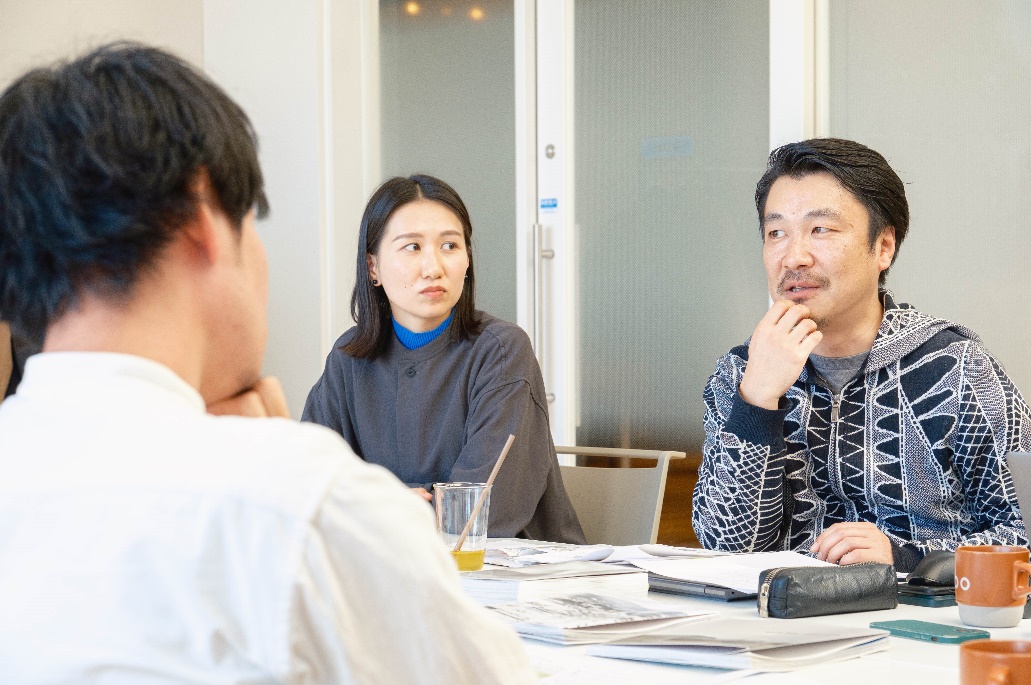
Okamoto
It would be interesting if "Potato Street" were eventually positioned as a road on Google Maps.
Creating a space that creates “encounters”
Okamoto
We have heard about "creating liveliness in the town" through attraction and flow lines, mainly with national highways and through-ways in mind, but how about "creating liveliness within the facility" through encounters and communication between facility users? Did you take that approach?
Mr. Otsuji
As Murakuni explained, the city has restarted with zoning that separates the town hall zone and the lively zone in the north and south.
From the beginning, we believed it was important that ``Potato Street'', which connects north and south, be a ``neutral space'' that does not belong to either function. It's similar to the feeling that roads don't belong to anyone, but belong to everyone.
As the design progressed, the importance and expectations for community spaces and cafes that anyone could easily visit and stay in increased, and the overall character of the facility as a core of ``bustling'' was strengthened. However, we are conscious of the fact that the town hall zone and the lively zone have an equal relationship, and we designed this facility without forgetting that it is also a town hall building. Based on this premise, we considered the meaning and effects of the coexistence of a town hall and bustle.
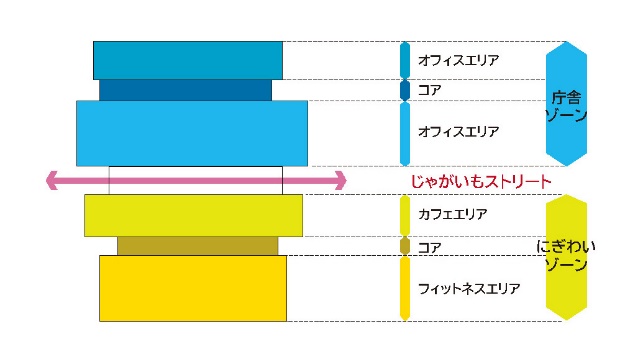
strip zoning diagram
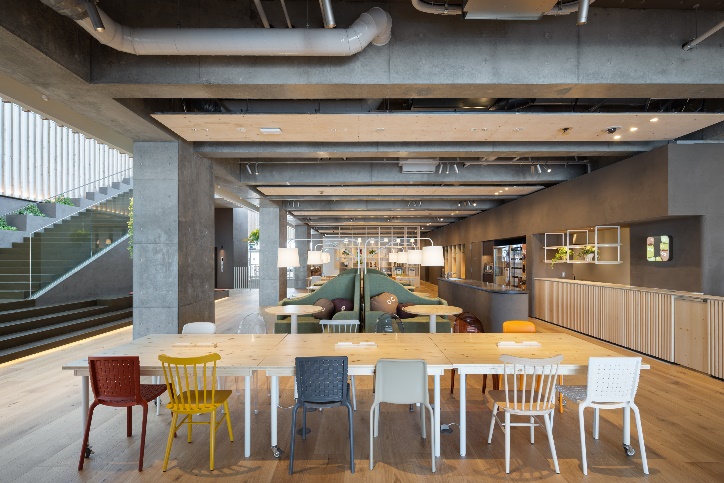
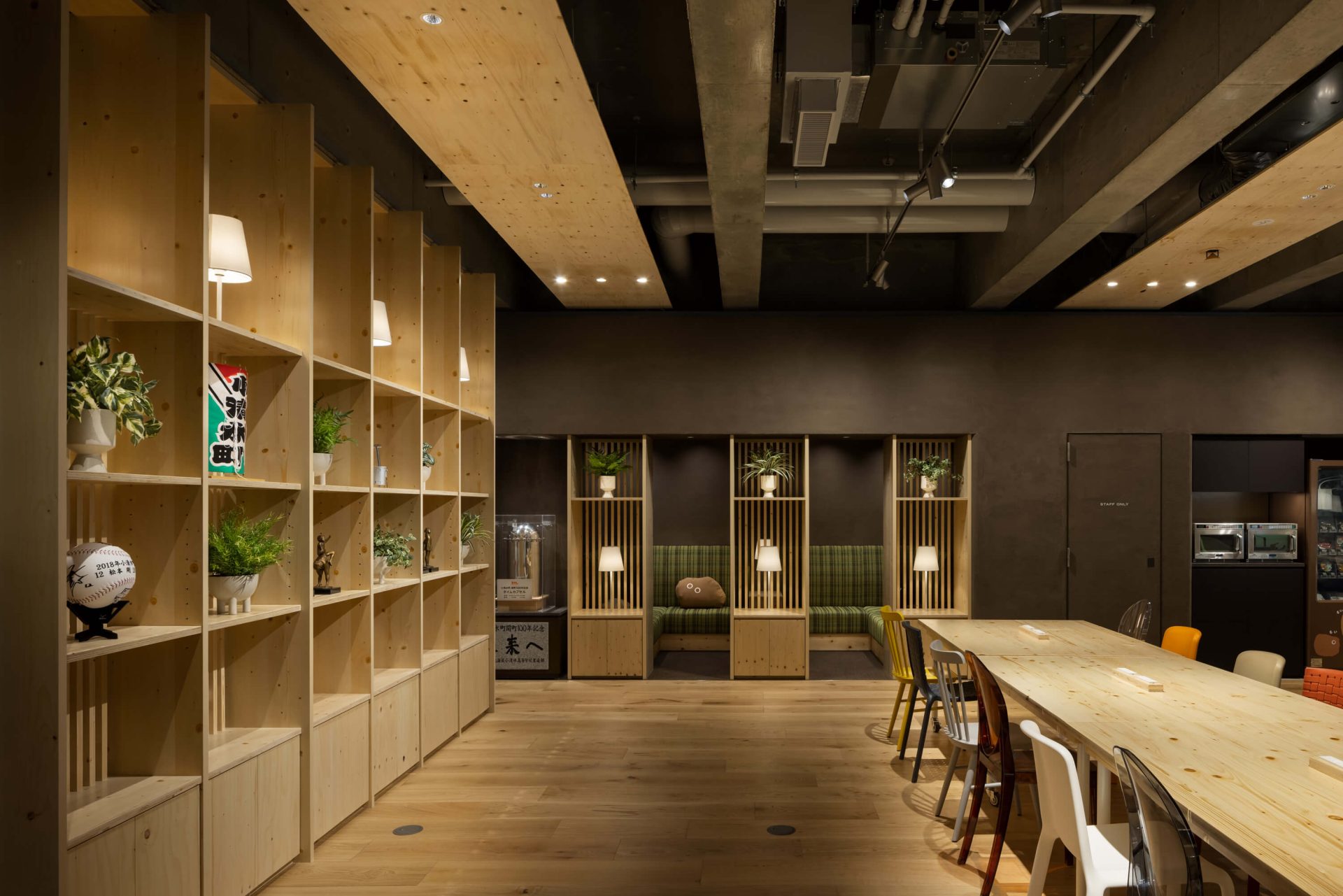
A community space with a variety of seating options that supports users' various activities.
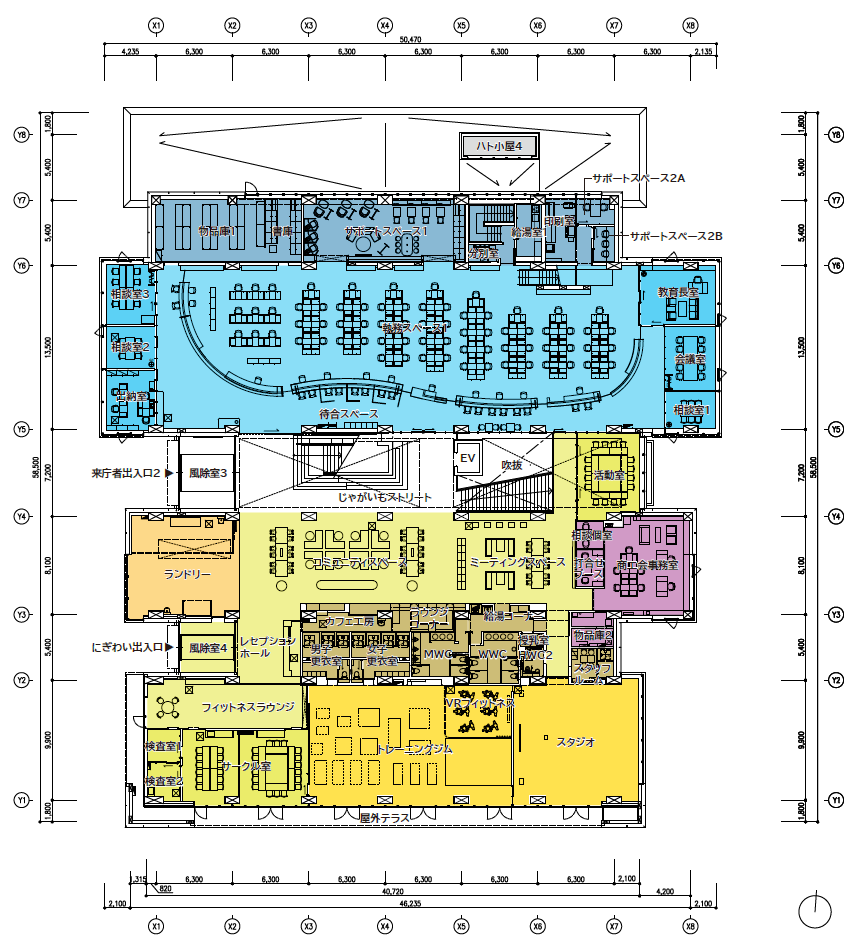
First floor plan (at the time of detailed design)
valley
We wanted office staff to come out of the counter and actively work and gather in the central zone, so we also set up a LAN exclusively for office staff in the community space. I have heard that they are now able to work in the middle of the city, away from their desks, and that they have become closer to the townspeople and are able to communicate more casually. It's bustling with staff and townspeople.
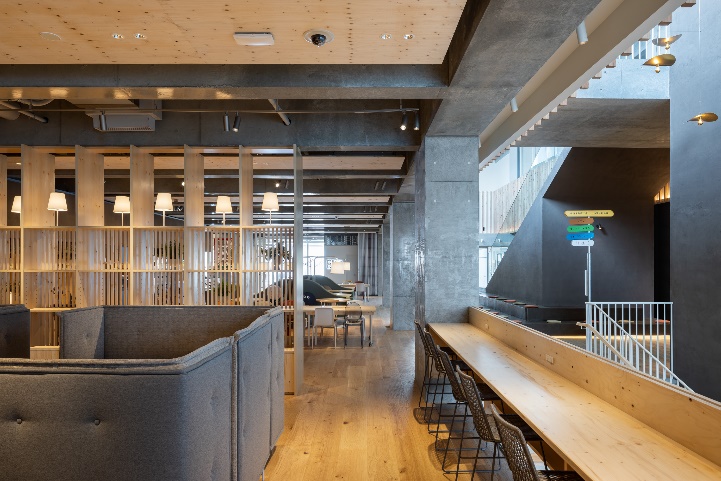
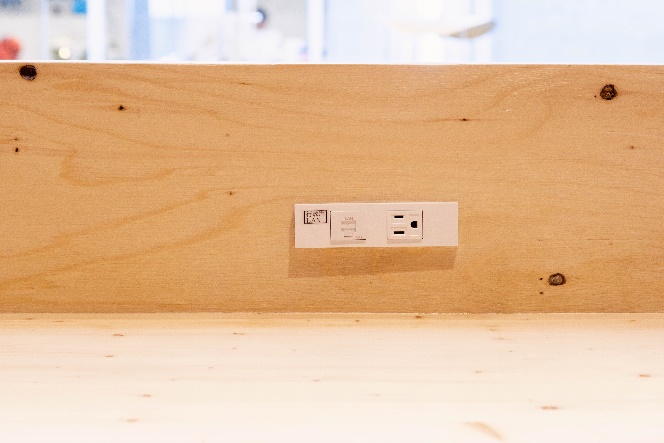
There are also counter seats with LAN exclusively for office staff.
Mr. Murakuni
Actually, this is the intention of the mayor and deputy mayor, but the restrooms on the first floor are only in the middle area. The office doesn't have it. Reducing the number of toilets has cost benefits, and I think it's a very good idea.
Mr. Otsuji
I was also impressed by the policy of ``minimizing zones that are only used by office staff'' in conference rooms.
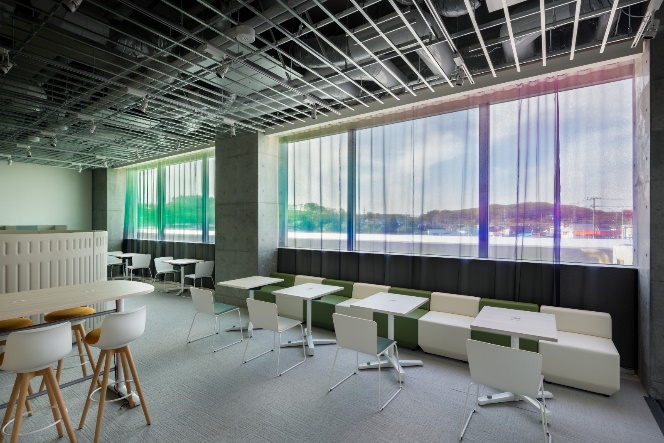
A support space that is shared by staff and designed to create a comfortable work environment for staff due to its minimal size.
Mr. Murakuni
The mayor and deputy mayor's commitment is not only to "create points of contact between staff and townspeople, between townspeople, and between staff," but also from the perspective of "avoiding the creation of rooms with a limited number of users and low occupancy rates." It was a logical plan for the complex. I think that constant use of space also leads to "creating vibrancy as a landscape."
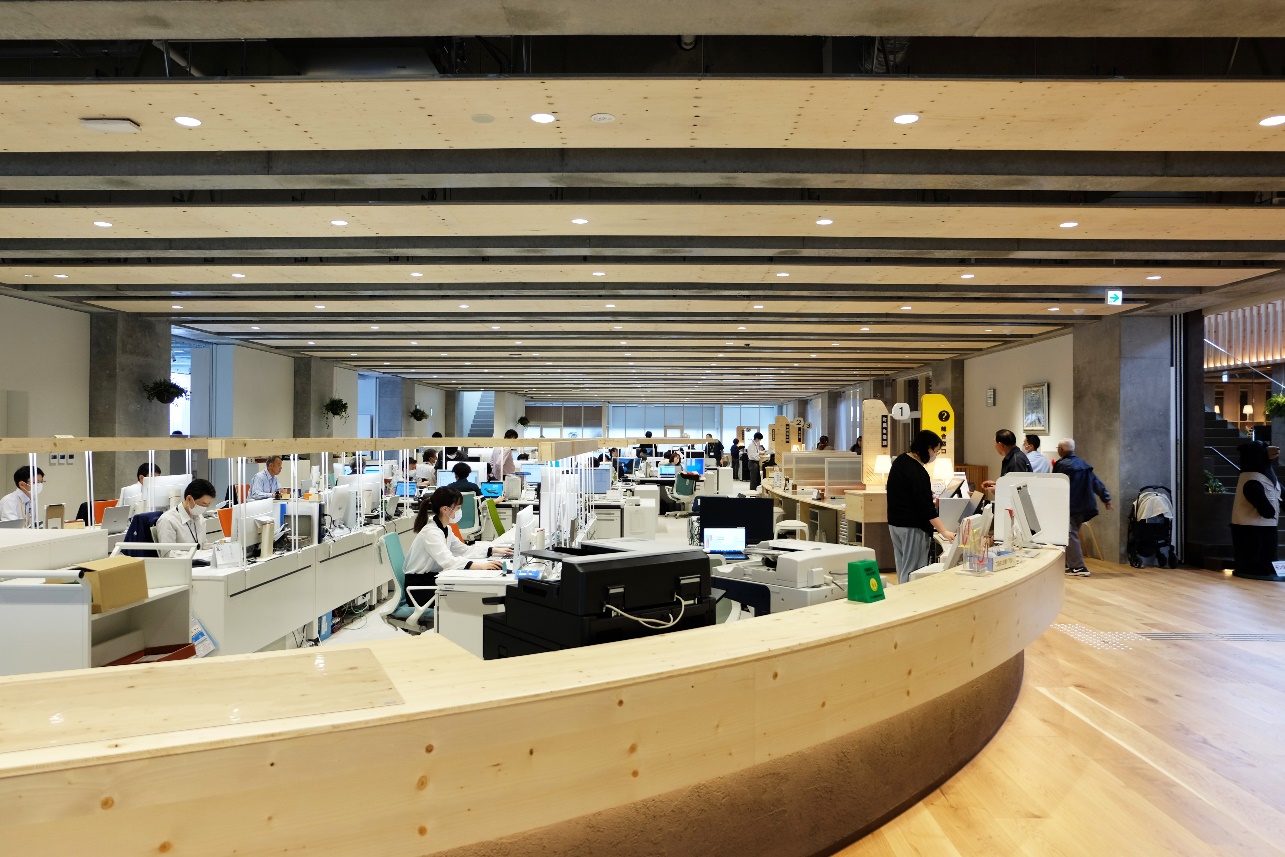
An integrated office space with good visibility and a constant presence of staff and users (provided by BNK)
Okamoto
All of them have wonderful perspectives and ideas.
The fact that functions that can be freely shared by anyone are gathered in the center, and it becomes a magnetic space, may be the key to creating a lively space.
A design that will excite visitors to the office
Okamoto
Next, I would like to ask the Nomura members: Regarding the liveliness within the facility, other than the area composition and functional improvements, are there any other aspects that you were particularly conscious of when designing the space?
valley
The mayor has said for some time that he wants to make it a place where children can play and have a comfortable time.
Therefore, rather than simply placing play equipment, we were conscious of creating an atmosphere throughout the facility that children could enjoy.
For example, on Potato Street, which is the backbone of the facility, there is something like a ``guide sign'', a space where you can chat using the stairs, and a space where you can hide out for a while. We created something that evokes a natural sense of excitement that is also connected to the bustle.

Toyota
The reason we adopted a guidepost-type design for the guidance sign was because we wanted visitors to be able to walk around the facility as if they were taking a walk in nature. As was mentioned earlier, this is also to create an image that is continuous with the outdoors, which is full of nature. There is an affinity with the name Potato Street, and we have created a space with attractive spaces throughout. Once again, I am glad that I chose this type of sign.
Mr. Otsuji
The desaturated colors and rounded organic shapes match the natural feel of the space.
valley
In terms of creating a sense of unity and atmosphere throughout the facility, it was decided that all of the lively functions would be operated by an NPO, which is the town's designated manager, so we wanted to make sure that it didn't look like only one tenant had moved in. We paid great attention to not only the design of the large surfaces but also the color of the small pieces of furniture.
In addition to the bustling areas, we also designed the counters in the town hall area in a similar way, using clay walls and counters with an organic shape inspired by the town's fields, creating a symbolic town hall counter.
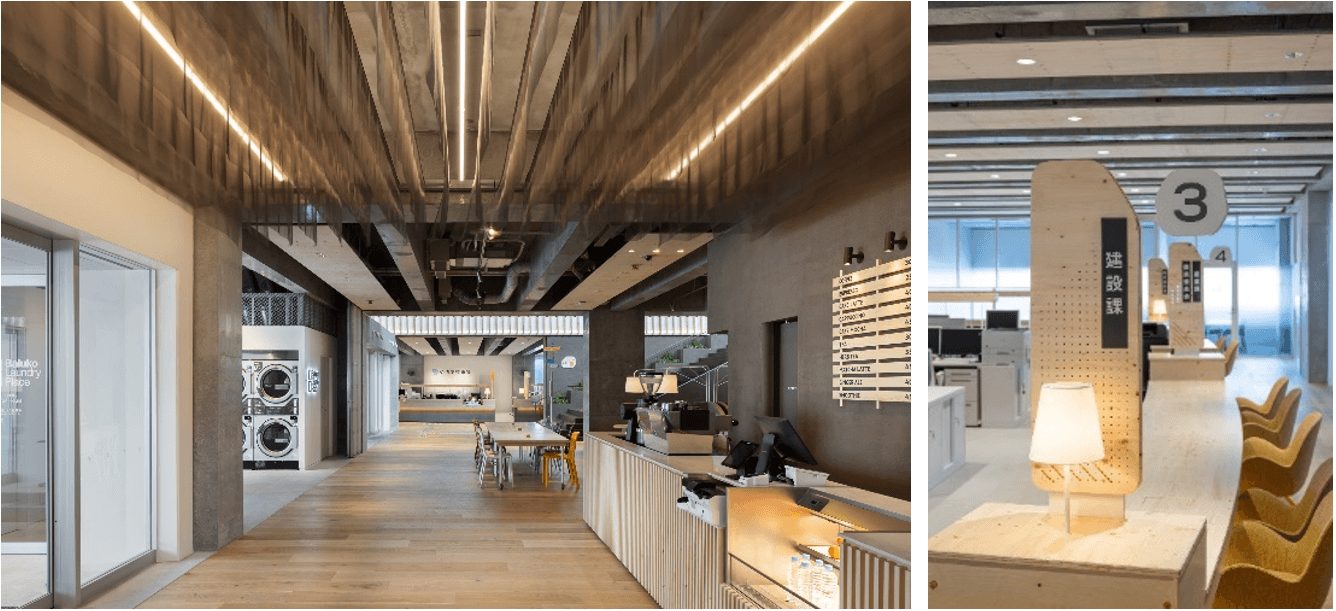
While the structure gently divides the space, materials and signs create a sense of unity.
Toyota
In the team I belong to called IVD, we always try to first create a worldview and unify all tools, and I think the talk of creating a sense of unity is also related to this. . As seen in Watashino's logo, we set four colors as the facility's VI (visual identity) inspired by the scenery that makes up Koshimizu Town, but Mr. Tani also applied various colors to the various materials in the space. The color also reflected that color. In addition, these four colorful colors also incorporate the concept of ``a government building with a variety of functions,'' and were used to divide the sign design into areas, and we deliberately refrained from using tenant logos. I think the facility has a sense of unity, bringing the worldview of Watashino, a large vessel, to the forefront.

Okamoto
It's true that it's a facility with a variety of functions, but the zoning and design are really well done.
Chat in the community space after the gym or grab a coffee while waiting for your laundry. I'm enjoying the various functions, but I never feel like I'm visiting different shops. That's why I don't feel like I'm coming to the town hall, laundry, fitness gym, or cafe, but instead I feel like I'm coming to Watashino.
In order for the name of the facility to become attached and familiar to the residents of the town, I believe that a sense of unity in the design is a very important element.
What is phase-free space design?
Okamoto
In addition to the keyword "bustling," I think the theme of "phase-free" was also very important from the perspective of disaster prevention. How did you grasp this unfamiliar concept and incorporate it into your design?
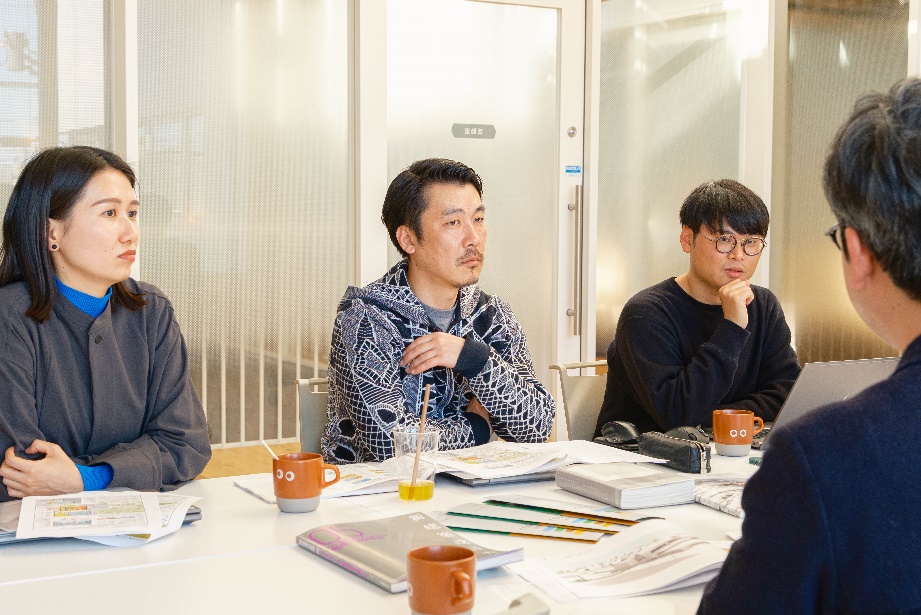
valley
A very easy-to-understand design example is that by making all of the tables and chairs in the community space movable, while supporting the free activities of the townspeople in normal times, it can be quickly turned into a flat evacuation area in the event of an emergency. .
Looking back, the first time NOMURA Co., Ltd. and Atelier Bunku met was at a Phase Free study session.
Mr. Murakuni
Including small stories, we all came up with over 180 ideas.
What was particularly interesting at the study session was the statement that ``Being able to use a familiar place as an evacuation site in an emergency gives disaster victims the greatest peace of mind.''
It's true that even if I suddenly find myself in an evacuation shelter that I'm not supposed to go to, I'm nervous, and I think it won't be easy to live a safe life as an evacuee.
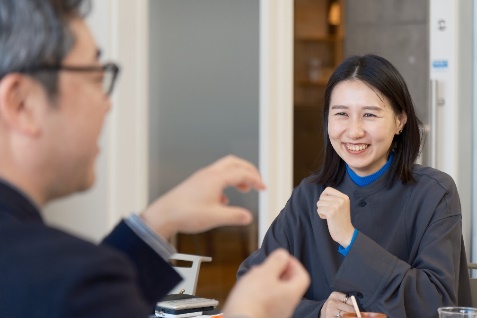
Mr. Otsuji
In the first place, the concept of "phase-free" was mentioned in the proposal, but disaster prevention function, which had previously been positioned as one of several themes, became a cross-theme theme along with "bustling," which seemed to be the opposite. I felt the strong will of the ordering party in what they expressed. Looking back on it now, I think it is a concept that has a high degree of affinity as a ``story'' that serves as a central axis in the recent trend of diversification and complexity of functions seen in public facilities. In this project, I think it was important to understand, as Murakuni said, that ``the liveliness of the place, not the atmosphere, leads to disaster prevention'' in determining the character of the space.
Okamoto
surely. More specifically, creating a space where townspeople and staff can interact naturally and get to know each other will lead to psychological peace of mind when guiding people during evacuations.
Before we put in a lot of detailed phase-free ideas, we first aim to make the base space ``a familiar space that is used on a daily basis,'' and then, in the event of an emergency, ``become a safe evacuation place.'' It is important to keep this in mind as a basic principle.
Mr. Otsuji
Now that various facilities, especially public facilities, are becoming more familiar and open to local communities and society, I thought phase-free could be an effective concept to expand the possibilities of space utilization..
For example, if there were something like "phase-free education," it would be possible to encourage people to look at the space and its furniture and realize that it could be used in a disaster, and to look at buildings from a new perspective. I might get it.
valley
If you hold a phase-free tour for elementary and junior high school students, you might get some interesting reactions.
Maybe people will realize that it's phase-free to a point we didn't intend. lol
Also, since the word "disaster prevention" itself has an image of being very rigid, I think it is the best word to express "disaster prevention with a sense of security" that gently and firmly envelops you, rather than strongly and violently protecting you. .
Watashino's special points walking tour
After the discussion in the activity room, we decided to actually tour the building and exchange opinions on the key points we were particular about.
To the symbolic atrium space at the back of Potato Street
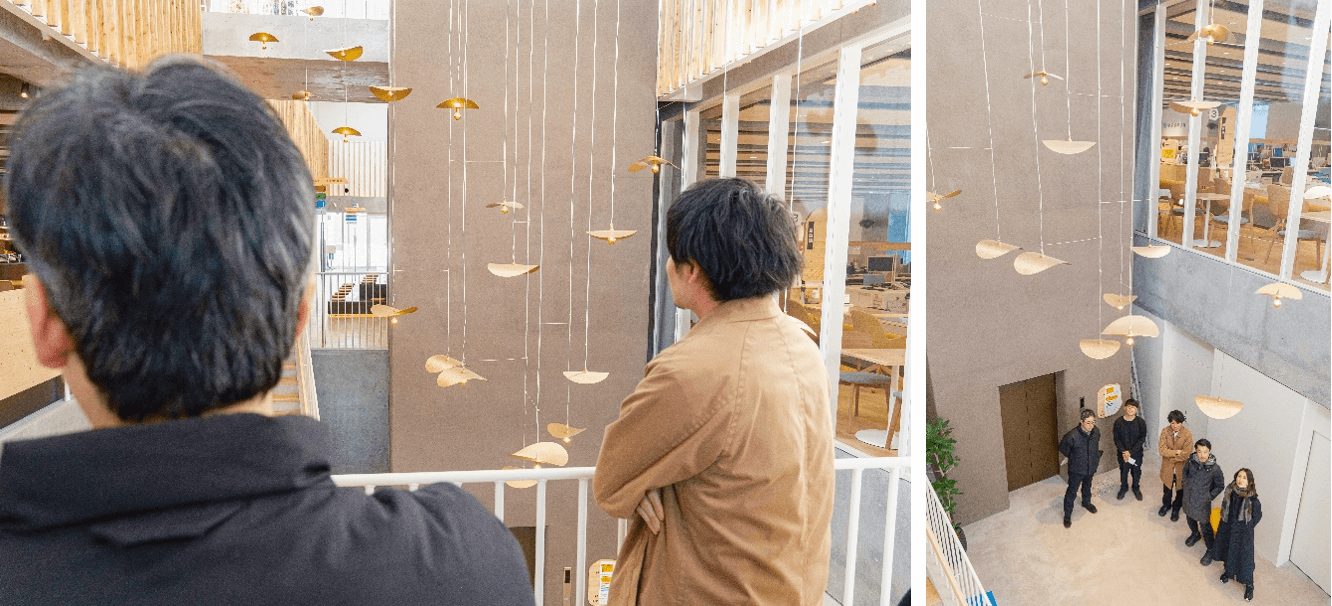
Mr. Otsuji
It may not be a place that people think about, but this space is actually my favorite.
The expressions of various materials intersect in three dimensions, such as the exposed concrete frame, the round steel handrail to prevent falling, the larch and fir decorative materials that float lightly as lines and surfaces, and the earthen walls and fabric that catch the light in contrast. I think it's interesting how they are.
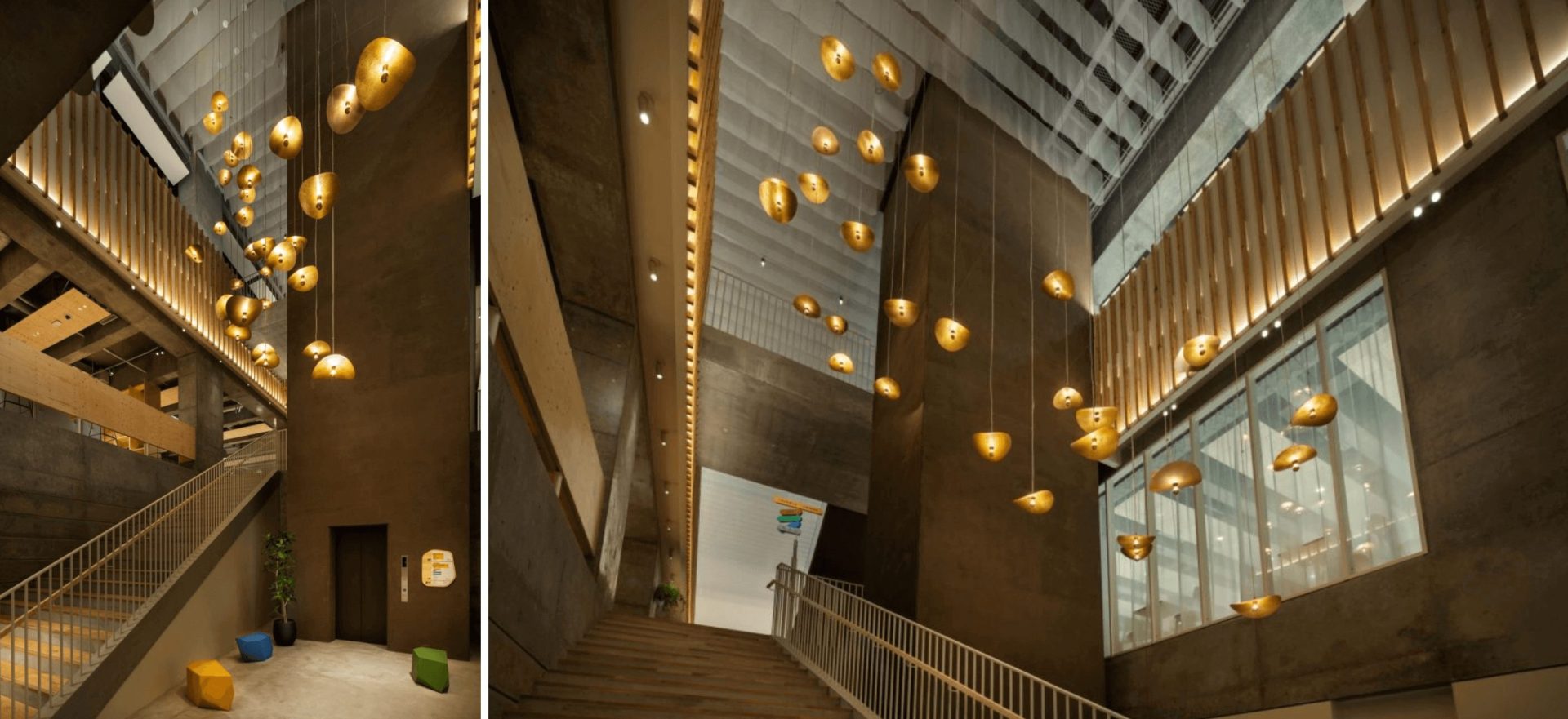
A three-story open-ceiling space seen from the basement level, which is connected to the national highway
valley
This atrium space is a very important place.
This atrium, which is the center of the facility, is also the center of the town. The center of the town is illuminated with the symbol of the town.
I wanted to create a landscape with a story that can only be told in this town.
Okamoto
Please tell us the story again. lol
valley
Koshimizu Town is a wild bird town, home to more than 300 species, which is said to be about half of the wild birds seen in Japan, and you can easily see many wild birds.The town's specialty, potatoes, is Calbee Potato Chips. It is also synonymous with Koshimizu, its birthplace. To recreate the sight of birds flocking together in Koshimizu's daily life, shades shaped like potato chips are placed one on top of the other, and the light represents the flight of birds in flocks.
The curvature of the shade causes the light to be diffusely reflected, and in total we were able to create a warm light in the center of the town using only the power of one 60w bare light bulb.
By adding charm and stories to the light that illuminates the center of town, we hope that not only visitors but also local residents can experience it on a daily basis.

Okamoto
Rather than a dynamic symbol, the concept of a calm and generous symbol matches the atmosphere of this facility and the town very well. It's a wonderful story no matter how many times I hear it.
From Potato Street, go through the indoor bus waiting area, bus stop, and exit the facility.

Mr. Murakuni
My favorite spots are actually the exteriors seen from various angles.
Rather than a large building towering over the national highway, we were conscious of the scale of other shops and buildings along the national highway, and created a size and shape that would be familiar to the people of the town. We decided on the volume of the building.
Depending on the angle you look at it, the building can look like a one-story building or terraced, so you can see the building's various expressions by walking around.
 Left: Low and long south side Middle: Parking lot side with one layer of different heights Right: National highway side where volumes of various heights can be seen (Photo provided by BNK)
Left: Low and long south side Middle: Parking lot side with one layer of different heights Right: National highway side where volumes of various heights can be seen (Photo provided by BNK)
Okamoto
It's truly amazing that so much thought has been put into it from the perspective of connecting with the townscape and the townspeople.
Indeed, ``my'' diverse activities are now visible even from the outside. Also, it was the first time I visited when it was snowing since it opened, and the color of the building really stood out against the snowy landscape.
Mr. Otsuji
The interior has a warm atmosphere, but we wanted the exterior to stand out against the snowy winter landscape.
In addition to the color, we used large precast concrete panels with hard corners for the exterior material, which tends to have detailed layouts and combinations of parts when using off-the-shelf products, to create highly accurate details and dynamics. I think we were able to create an appearance that combines these qualities.
Mr. Tani
The exterior structure, which Atelier Bunk is continuing to work on, will finally be completed this year, so I'm really looking forward to it.
I think a new landscape will be created when the richly vegetated landscape and the government building are seen together.
Returning from the outside to the main entrance that creates the first impression of the facility.

Mr. Tani
This is definitely my favorite point.
Centering around the earth-colored staircase ``Watashino-oka'', which was inspired by the rich land of Koshimizu Town, wood from Hokkaido is used to incorporate the landscape of Koshimizu Town, including earth, wood, greenery, and sky, into the interior. Additionally, by changing the color temperature of the lighting compared to the adjacent office space, we created an overall warm atmosphere while still letting in natural light from the ceiling.
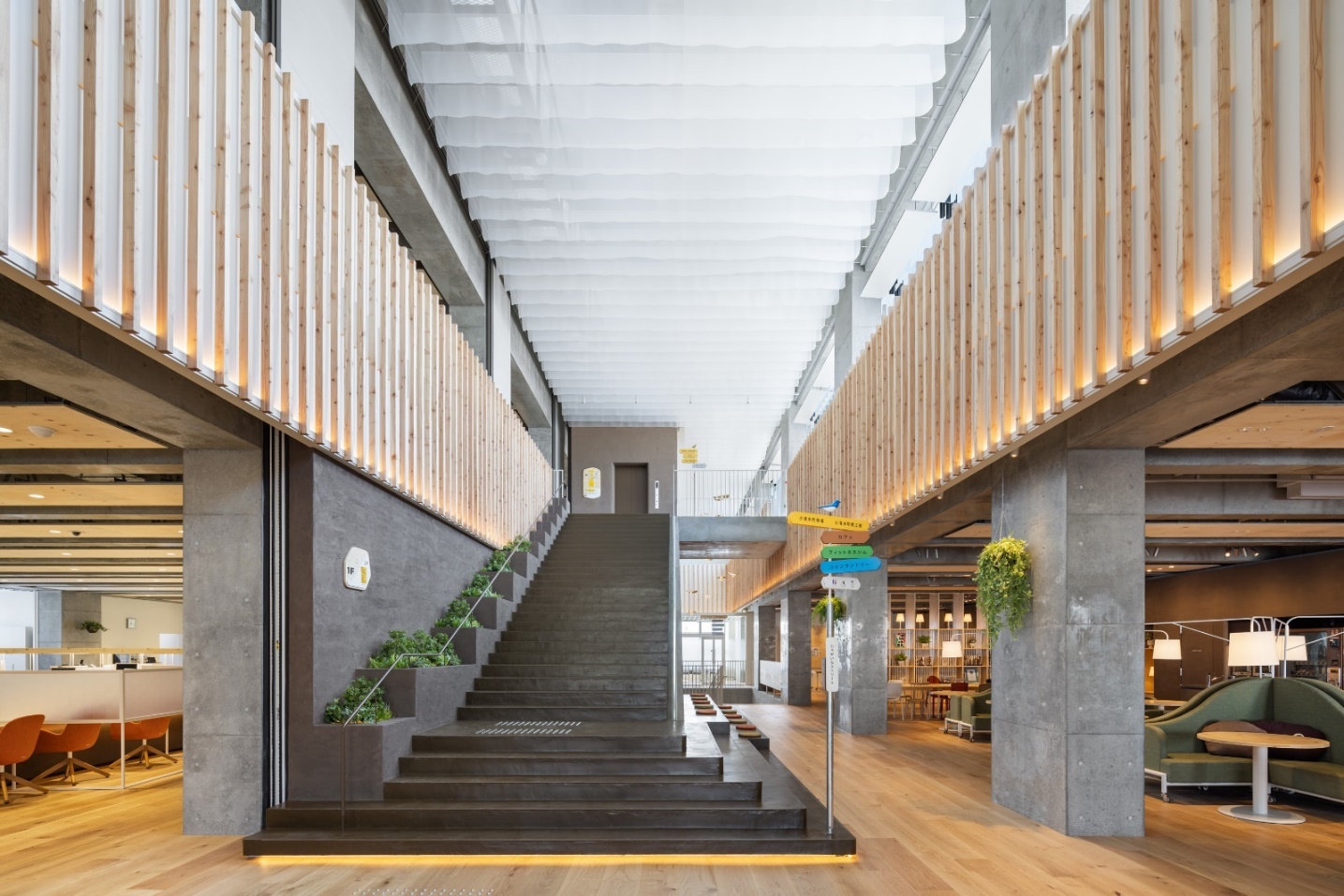
Mr. Murakuni
We asked textile designer Akane Moriyama to design the fabric louvers on the ceiling. The way it sways even with the slightest airflow inside the room, gently diffusing the light from outside, makes it look like a cloud, making the open space even more appealing.
Toyota
My favorite place is the entrance where VI and sign design concepts come together.
As you enter the facility, colorful symbols appear as signposts, pointing in all directions, and organically shaped signs are placed on the earthen walls, looking like dug-out potatoes.
In addition, since Koshimizu Town is said to be a sacred place for bird watching in Japan, the museum is dotted with objects depicting birds that actually gather in this town, bringing the joy of finding a wide variety of birds into the space. Masu.
I believe that the essence of ``creating a sense of unity and liveliness in a facility'' resides in such small details.
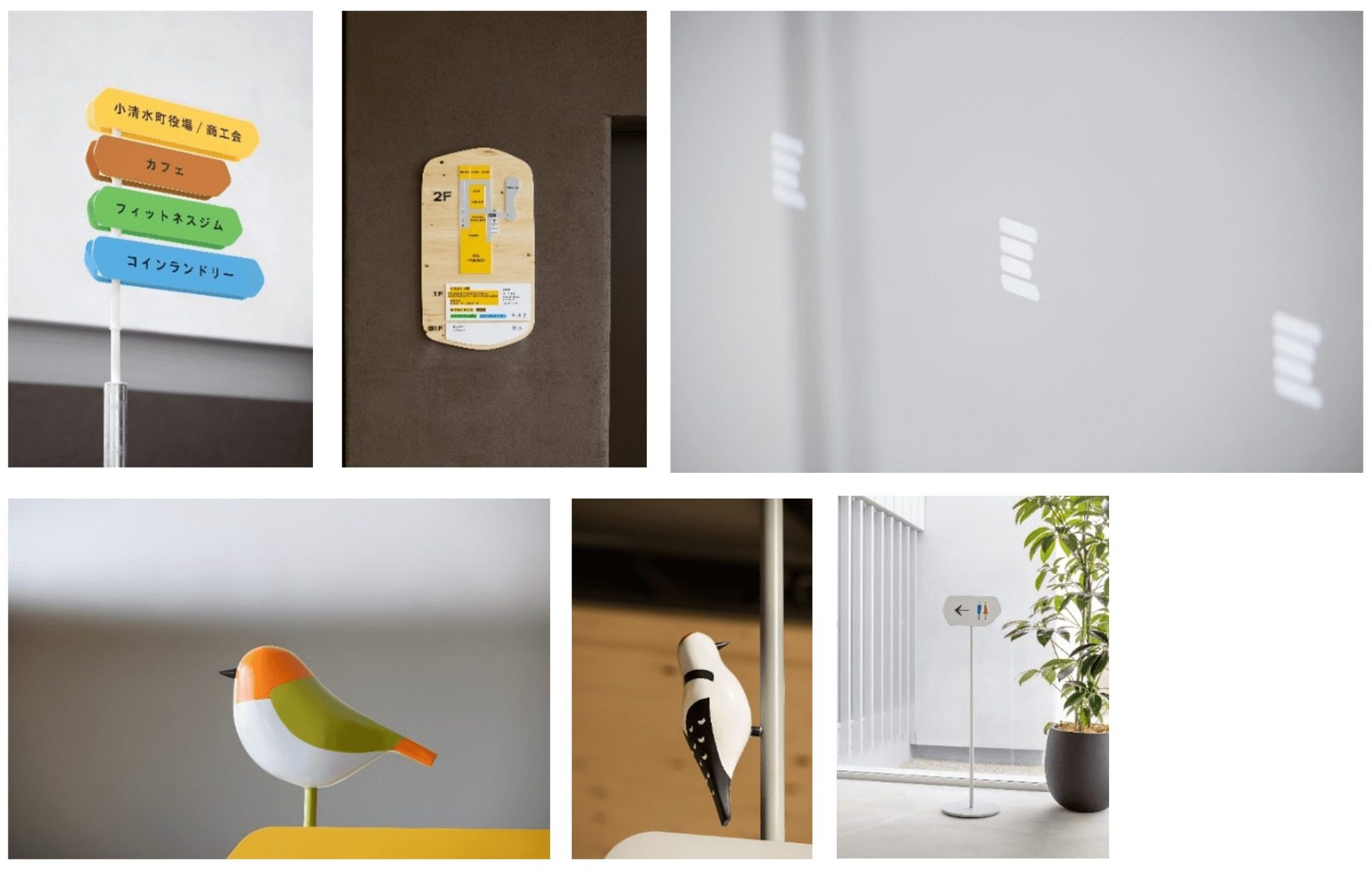
Okamoto
At the opening ceremony that we produced, we also created a giant potato kusudama that looked just like the real thing. I remember being really moved by the sight of local children breaking the Kusudama balls with sparkling eyes, and then having fun looking for birds inside the museum.
I hope that the children who grow up with this facility will become attached to it and take pride in this charming town.
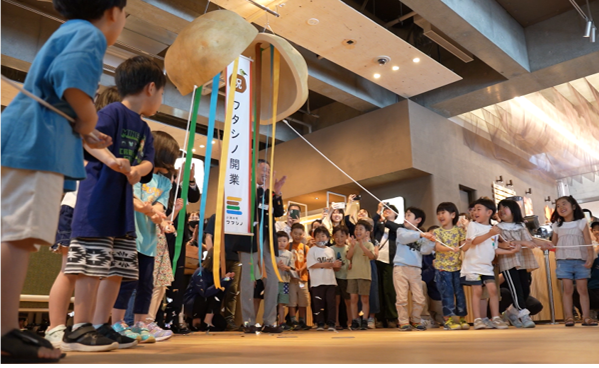
Looking back at the project
Mr. Otsuji
This time, I was able to work with NOMURA Co., Ltd. again and realized many things.
In addition to exploring the design, we also organized opinions and requests from various private companies and organizations with an understanding of the end user's position, and reflected them in specific functions, zoning, etc. NOMURA Co., Ltd. 's commitment to upstream planning is instructive.
On the other hand, this building would not have been possible without the cooperation of local builders and craftsmen located downstream. In fact, the boundaries between the public and private sectors, especially in the field of architectural design and manufacturing, become increasingly blurred the further down the river you go. However, it is difficult to share this with many stakeholders.
Another important point is that both the ``town hall'' and the ``bustiness'' are economically viable in terms of hardware. I think this is a very rare project in which people from various positions were able to share such values as a consensus.
valley
Atelier Bunk was responsible for the planning and design of the entire facility, while NOMURA Co., Ltd. was responsible for planning the busy areas, interior design, FFE, and signage design including the facility logo. . However, there were times when we had heated discussions about each other's missions and non-negotiable points. lol
Once again, many stakeholders, including not only us, but also everyone in the city hall, other private companies, the Phase Free Association, and the Chamber of Commerce and Industry, are involved, and we are truly making this happen. "A facility created by everyone" I think so.
Because we worked as one team, not only from the design, but from the planning to the final opening, No matter who explains it, they can tell the same story about the appeal of Watashino's projects and facilities. I think it's a good project and facility.
Toyota
It was my first time to be in charge of a large-scale facility like this one, and although it was difficult at times, I learned a lot, and I can see how happy the people who visited the facility were after it opened. It was a great encouragement to be able to do so. At first, we considered creating a facility logo with a complex shape to express the facility's diversity of functions, but in a discussion with Atelier Bunk, he said, ``The architectural plan is so clean that it doesn't feel right.'' I remember that I felt very refreshed when I received your opinion.
Through this experience, I received many new perspectives for future design challenges, such as how to understand the meaning of architecture as its specifications, and how to think about grid-like exteriors. At first glance, architecture and graphic design seem to be completely different fields, but there are many things that we can relate to, and through collaboration we were able to reach a place that we could not have reached alone.
Mr. Murakuni
Building architecture in a big city like Tokyo and building architecture in a rural town like Koshimizu. This made me think once again that the social impact that a single building can have can be completely different depending on its location. If it's the former, no one will even notice if a building is built, but if it's the latter, I think it's possible that the town's appearance could change all at once. Through this project, I was once again reminded of the power that architecture and design can have on a town.
I also think that ``bustling'' meant how to create an ``urban-like situation'' inside and outside the building. By having a diverse group of project members, we were able to consider the project from various aspects, and as a result, we were able to create a ``small town'' architecture that would please the people of the town.
We came to the office today for the first time in a long time, and no one paid any attention to us wandering around. I felt that this is a place where a wide variety of activities are truly accepted.
Okamoto
You're right. Even so, there is still plenty of space and space.
Free activities and various functions form the landscape, and your feet naturally move forward in the open space. This may be an exaggeration, but it's enough to make you want to walk slowly.
There is no hierarchy in all functions and the design is unified, making you feel as if time is passing peacefully. It's a comfortable place, and I think everyone will feel like it's their home.
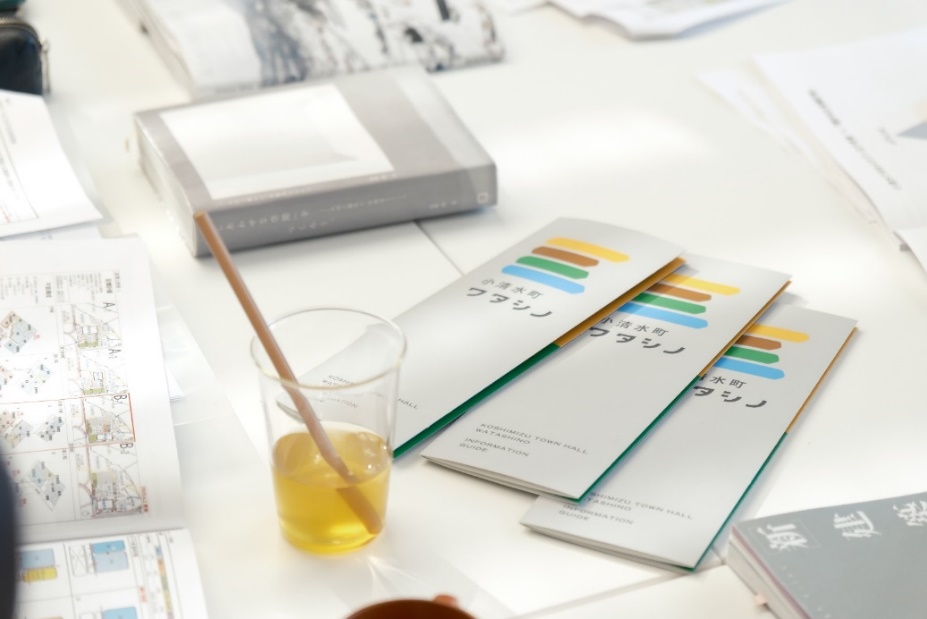
Completion photo © 2023 Nacása & Partners Inc.
Interview photo © 2024 Hokuei northern films
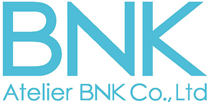
WEB http://www.atelier-bnk.co.jp/

IVD-Integrated Visual Design
NOMURA Co., Ltd. 's specialized visual and graphic design unit creates new brand value through a creative style that approaches space from a visual perspective.
IVD official instagram https://www.instagram.com/ivd_official/
Like this article?
